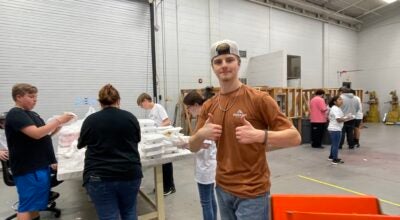Georgia thumpers begin thumping around the state
Published 8:37 am Saturday, June 28, 2014
Earlier this week, a Bainbridge resident asked me to take a look at his garden. While we were looking around and talking about his peppers and tomatoes, we came across a huge black and yellow grasshopper sitting in the top of a shrub. It was a Romalea microptera, also known as an Eastern Lubber, or the Georgia Thumper.
These monstrous grasshoppers are so large that it is hard not to notice them.
The males are about three inches long and females are even bigger at around 4 inches.
Their color can vary greatly from a dark yellowish brown with black markings to solid black with yellow markings. Adults have wings that extend about halfway down their abdomen with reddish pink coloring. Juveniles will not have fully developed wings until they reach maturity. Despite having wings, Lubbers are flightless insects. Their wings are purely for show. Lubbers have long, powerful looking legs, though because of their large body size, the adults rarely jump. Instead, they move around by walking and crawling clumsily.
Lubbers usually have one generation per year. They begin hatching from eggs that were laid in the soil in March/April as the ground warms. It takes around two months for the nymphs (juvenile lubbers) to fully mature. Once they reach maturity, Lubbers will mate and during the summer months, the females will lay eggs in the soil. There the eggs will stay until the following spring.
Georgia Thumpers have an interesting defense mechanism to keep predators from eating them. Within their bodies, they produce a toxin that can make birds and mammals sick. Most predators know to stay away because of the lubber’s bright colors, but the occasional glutton for punishment will begin vomiting soon after ingesting one. If you have a curious dog like mine, it would be best not to let him eat one.
Gardeners and homeowners seem to get nervous when they find a Georgia Thumper on or near their plants. It seems logical that due to their size, they would have a tremendous appetite and just a couple could destroy a garden. However, this just isn’t the case. Though they are huge, Lubbers have a fairly small appetite and generally don’t cause much damage. The exception to this could be where there is a large group of juveniles that have not yet dispersed.
You’ll know them by the absence of wings. If a large group of juveniles is present and causing noticeable damage, a pyrethroid insecticide can be used to kill them, though this is rarely necessary. Usually there are few enough that you can pick them off and throw them in a bucket of soapy water, just step on them, or you can also bring them to me-I think they’re cool.
For more information on Georgia Thumpers or to see one up close, please feel free to come by or contact me at the UGA Decatur County Extension office. (229) 248-3033




